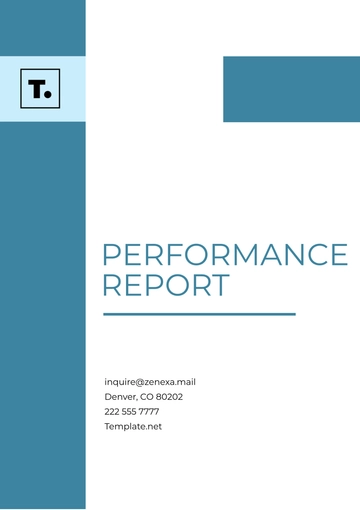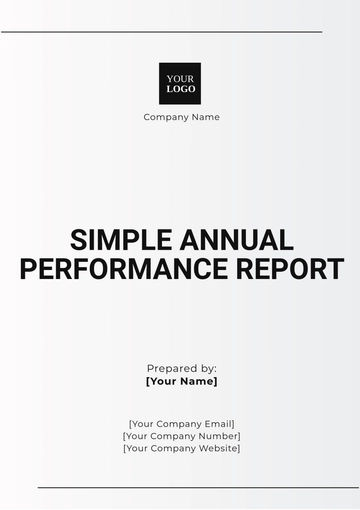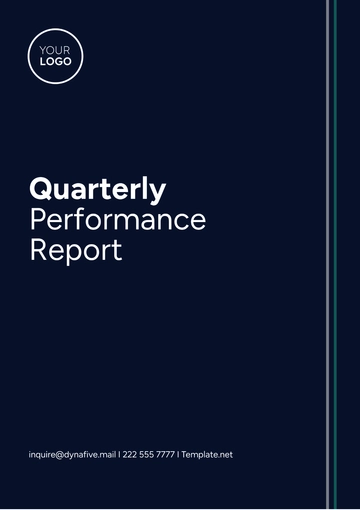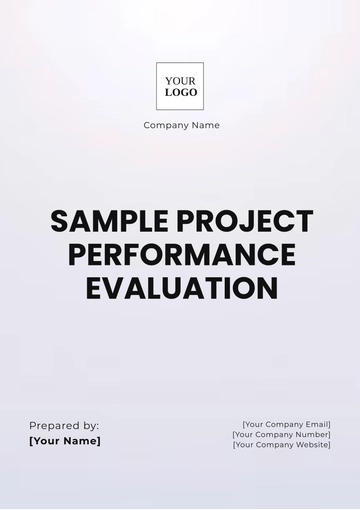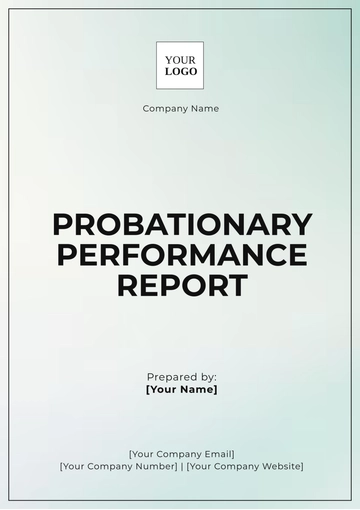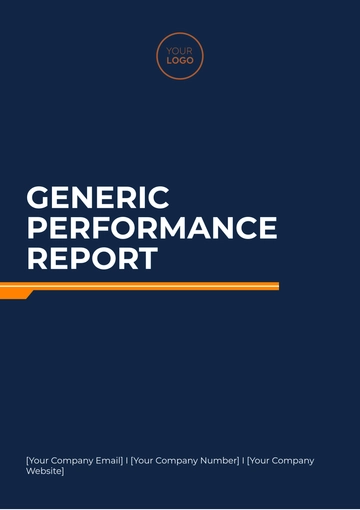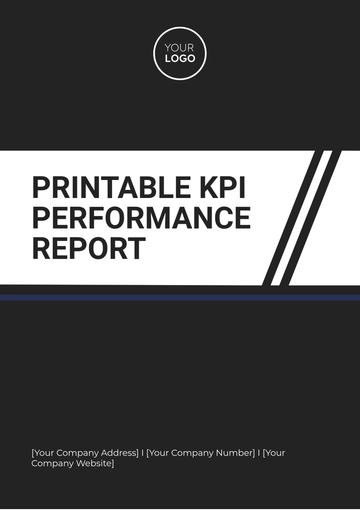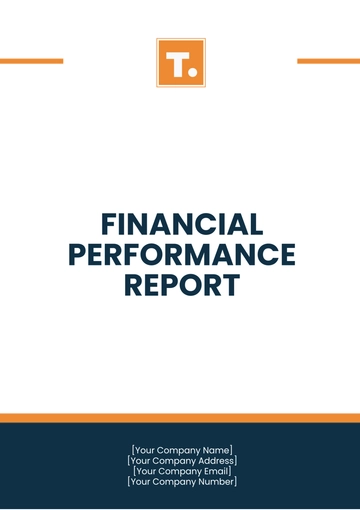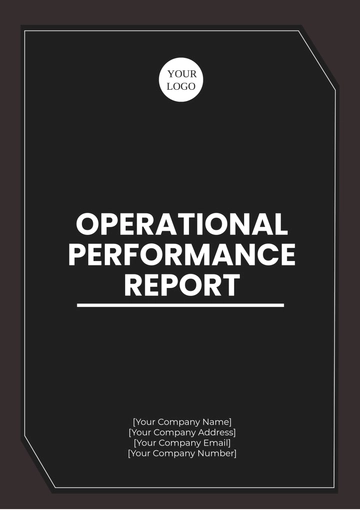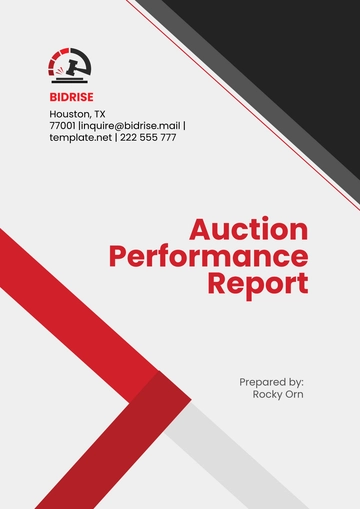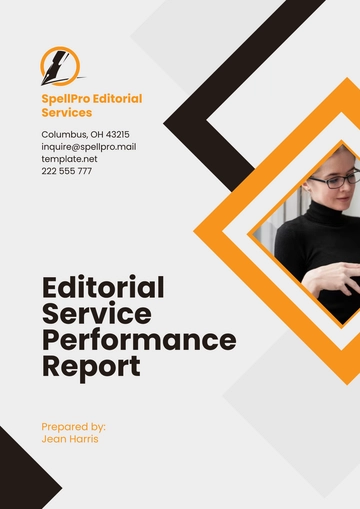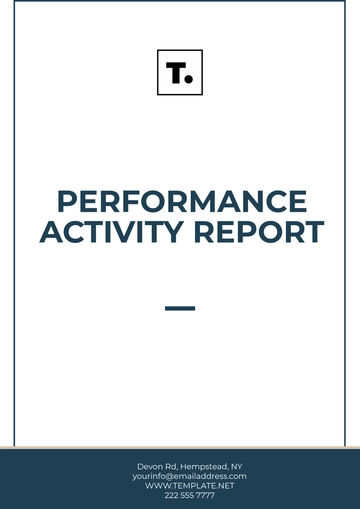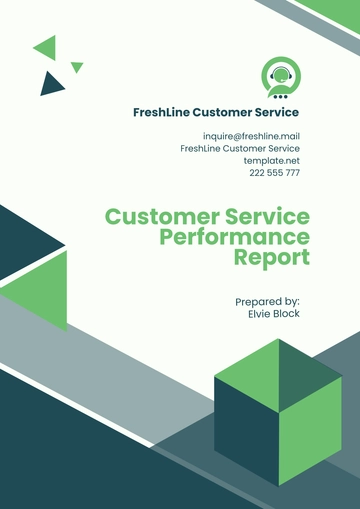Free Sales Year-end Client Performance Report

Executive Summary
This Year-end Client Performance Report encapsulates a comprehensive review of our sales performance, client engagement, and financial outcomes over the past year. Despite the challenges of a fluctuating market environment, we achieved a commendable 15% growth in overall sales revenue compared to the previous year. Our strategic focus on expanding our digital product line led to a remarkable 25% increase in sales in this category, demonstrating our ability to adapt and thrive in a digital-first marketplace.
Key achievements include the successful acquisition of 200 new clients, a testament to the effectiveness of our targeted marketing strategies and the dedication of our sales team. Client retention rates remained strong at 85%, underscoring the value our clients find in our products and services. Additionally, our efforts to optimize client engagement through personalized marketing campaigns resulted in a 30% increase in average order value across our client base.
Purpose of the Report
The primary objective of this report is to provide a detailed analysis of our sales and client management activities over the past year, highlighting our successes, understanding the challenges faced, and identifying opportunities for future growth. By examining key metrics and client feedback, we aim to refine our sales strategies and enhance client satisfaction. This report serves as a critical tool for informed decision-making and strategic planning as we move forward.
Methodology
The analysis presented in this report is based on comprehensive data collected from various sources, including our Customer Relationship Management (CRM) system, financial records, client feedback surveys, and market research. We employed quantitative methods to evaluate sales performance, client acquisition and retention rates, and financial metrics. Qualitative analysis was also conducted to assess client satisfaction and gather insights from client testimonials and case studies.
Data were segmented by product lines, client demographics, and geographical regions to provide a granular view of our performance across different aspects of the business. Comparative analysis was used to benchmark this year's performance against the previous year, highlighting growth trends and areas for improvement. All findings and recommendations are derived from this data-driven approach, ensuring accuracy and relevance to our strategic goals.
Sales Performance Overview
This year has been pivotal in demonstrating our agility and responsiveness to market demands, leading to significant growth and achievements across our sales operations. Our strategic initiatives aimed at enhancing product offerings, optimizing client engagement strategies, and expanding into new markets have collectively contributed to a robust sales performance. The following sections provide a detailed breakdown of our annual sales figures, performance across different product lines, and our success in client acquisition and retention.
Annual Sales Summary
Year | Total Sales ($) | Year-over-Year Growth (%) |
Previous Year | 2,500,000 | - |
This Year | 2,875,000 | 15% |
The table above illustrates a commendable 15% growth in total sales compared to the previous year, with sales figures rising from $2.5 million to $2.875 million. This growth is attributed to our strategic focus on digital transformation and expanding our product range, which allowed us to capture new market segments and respond effectively to changing consumer behaviors.
Sales by Product/Service
Product/Service | Sales ($) | Percentage of Total Sales (%) |
Product A | 1,150,000 | 40% |
Product B | 862,500 | 30% |
Service C | 575,000 | 20% |
Service D | 287,500 | 10% |
Product A emerges as the top performer, contributing to 40% of the total sales, indicating strong market demand and customer preference for this offering. Product B also shows substantial success, accounting for 30% of sales. Service C and D, while contributing less to the overall sales, present significant growth opportunities, especially considering evolving market needs and potential for service innovation.
Client Acquisition and Retention
Metric | Previous Year | This Year | Change (%) |
New Clients Acquired | 150 | 200 | +33% |
Client Retention Rate (%) | 80% | 85% | +6.25% |
Our client acquisition efforts have yielded impressive results, with a 33% increase in new clients compared to the previous year. This success underscores the effectiveness of our marketing strategies and the appeal of our product and service offerings. Equally important, our client retention rate improved by 6.25%, from 80% to 85%, reflecting our commitment to client satisfaction and the strength of our client management practices. These trends highlight our ability to not only attract new business but also to cultivate lasting relationships with our clients, forming a solid foundation for sustained growth.
Client Engagement Analysis
Our approach to client engagement over the past year has been characterized by a strategic, data-driven effort to deepen relationships and enhance the overall client experience. Through personalized communication, targeted marketing campaigns, and a focus on delivering value, we have sought to increase engagement levels across our client base. This section delves into the key metrics of purchase frequency, average order value, and client feedback scores, alongside an analysis of client segmentation and the effectiveness of our marketing and sales campaigns.
Engagement Metrics
Metric | Previous Year | This Year | Change (%) |
Purchase Frequency | 2.5 | 3.0 | +20% |
Average Order Value ($) | 450 | 500 | +11.1% |
Client Feedback Score | 4.2/5 | 4.5/5 | +7.1% |
The engagement metrics reveal a notable improvement in client interaction with our offerings. Purchase frequency increased by 20%, indicating a higher rate of repeat purchases throughout the year. The average order value saw an uplift of 11.1%, reflecting our success in upselling and cross-selling efforts. Furthermore, the client feedback score improved from 4.2 to 4.5 out of 5, underscoring the positive reception of our product enhancements and customer service improvements. These trends collectively suggest stronger client engagement and satisfaction.
Client Segmentation
Segment | Percentage of Total Clients | Average Spend ($) | Preferred Products/Services |
Small Businesses | 40% | 1,200 | Service C, Product A |
Enterprises | 30% | 5,000 | Product B, Service D |
Individual Users | 30% | 300 | Product A, Service C |
Client segmentation has provided valuable insights into the diverse needs and behaviors of our client base. Small Businesses, making up 40% of our clients, show a strong preference for Service C and Product A, with an average spend of $1,200. Enterprises, though fewer in number, contribute significantly to our revenue with an average spend of $5,000, favoring Product B and Service D. Individual Users, equally constituting 30% of our clients, tend to spend less per transaction but show high engagement with Product A and Service C. Tailoring our strategies to these segments can further enhance client satisfaction and spending.
Campaign Effectiveness
Campaign | Target Segment | Increase in Sales (%) | Client Engagement Uplift (%) |
Digital Product Launch | Individual Users | 15% | 20% |
Enterprise Solution Promo | Enterprises | 25% | 15% |
Small Business Bundle | Small Businesses | 10% | 25% |
Our targeted campaigns have significantly impacted sales and client engagement across different segments. The Digital Product Launch aimed at Individual Users resulted in a 15% sales increase and a 20% uplift in engagement, demonstrating the effectiveness of personalized digital offerings. The Enterprise Solution Promo led to a 25% increase in sales within the Enterprises segment, with a 15% engagement uplift, highlighting the value of tailored solutions for larger clients. Lastly, the Small Business Bundle campaign saw a 10% sales increase and a 25% rise in engagement among Small Businesses, indicating the appeal of bundled offers. These results underscore the importance of segment-specific campaigns in driving both sales and client engagement.
Financial Performance Analysis
The financial performance over the past year reflects our strategic focus on optimizing revenue streams, enhancing profitability, and efficiently managing costs. Through targeted sales strategies and client engagement initiatives, we've seen significant financial outcomes across various aspects of our business. This analysis provides an in-depth look at our revenue distribution by client segments, products/services, and regions, evaluates profitability to identify high and low-performing areas, and reviews cost implications of client acquisition and service delivery.
Revenue Analysis
Category | Revenue ($) | Percentage of Total Revenue |
Client Segment: | ||
- Small Businesses | 1,200,000 | 40% |
- Enterprises | 1,050,000 | 35% |
- Individual Users | 625,000 | 25% |
Product/Service: | ||
- Product A | 800,000 | 27% |
- Product B | 900,000 | 30% |
- Service C | 675,000 | 23% |
- Service D | 500,000 | 20% |
Region: | ||
- North America | 1,500,000 | 50% |
- Europe | 900,000 | 30% |
- Asia-Pacific | 475,000 | 20% |
Revenue distribution highlights the significant contributions of small businesses and enterprises to our total revenue, accounting for 40% and 35% respectively, with individual users contributing 25%. Product-wise, Product B emerged as the top revenue generator, followed closely by Product A, indicating strong market demand for these offerings. Geographically, North America remains our largest market, contributing half of the total revenue, with Europe and Asia-Pacific also showing substantial contributions. These insights emphasize the importance of diversifying our client base and product offerings to sustain and grow revenue streams.
Profitability Analysis
Product/Service | Profit Margin (%) |
Product A | 30% |
Product B | 25% |
Service C | 40% |
Service D | 15% |
Service C stands out with the highest profit margin at 40%, making it our most profitable offering, while Product A and Product B also show healthy margins of 30% and 25%, respectively. Service D, however, has a lower margin at 15%, indicating potential areas for cost optimization or pricing adjustments. This profitability analysis underlines the importance of focusing on high-margin services and products while exploring strategies to enhance the profitability of lower-margin offerings.
Cost Analysis
Cost Category | Amount ($) | Percentage of Total Costs |
Client Acquisition | 300,000 | 20% |
Client Servicing | 450,000 | 30% |
Marketing & Sales | 750,000 | 50% |
The cost analysis reveals that marketing and sales expenses constitute the largest portion of our total costs at 50%, followed by client servicing at 30%, and client acquisition at 20%. While these investments have contributed to our revenue growth and client base expansion, there's an opportunity to review and optimize our spending, particularly in marketing and sales, to improve overall cost efficiency and profitability. This could involve evaluating the effectiveness of various marketing strategies and focusing on high-ROI activities to reduce costs without compromising growth.
Recommendations
Based on the comprehensive analysis of our sales performance, client engagement, financial outcomes, and the challenges and opportunities identified throughout this report, we propose the following strategic recommendations to bolster our growth and enhance client satisfaction in the coming year:
Intensify Focus on High-Margin Products and Services: Prioritize marketing and development efforts on Service C and Product A, which have demonstrated high profitability and strong market demand.
Optimize Marketing and Sales Expenditure: Conduct a thorough review of marketing and sales activities to identify and allocate resources towards the most effective strategies, reducing overall expenditure while maintaining growth.
Expand Digital Offerings: Leverage the growth in digital product sales by expanding our digital offerings, catering to the increasing demand for digital solutions among our client base.
Enhance Client Segmentation and Personalization: Deepen our client segmentation efforts to tailor marketing, sales, and product development strategies more effectively to the unique needs of different client segments.
Strengthen Client Retention Strategies: Implement targeted initiatives aimed at improving client retention rates, including loyalty programs, enhanced client support, and personalized client engagement activities.
Explore New Markets: Given the significant revenue contributions from North America and the potential in Europe and Asia-Pacific, explore strategic opportunities for expansion in these and other emerging markets.
Enhance Productivity and Efficiency in Service Delivery: Identify and implement process improvements and technologies that can enhance service delivery efficiency, particularly for lower-margin services.
Conclusion
This Year-end Client Performance Report has provided valuable insights into our sales performance, client engagement, and financial health over the past year. Despite facing a dynamic market environment, we have achieved notable successes, including revenue growth, enhanced client engagement, and expanded market presence. The analysis has also highlighted areas for improvement and strategic opportunities that we are well-positioned to capitalize on. Moving forward, by implementing the recommended strategies, we can continue to build on our strengths, address our challenges, and drive sustained growth and client satisfaction. Our commitment to innovation, client-centricity, and operational excellence will guide our efforts as we look forward to another year of achievement and progress.
- 100% Customizable, free editor
- Access 1 Million+ Templates, photo’s & graphics
- Download or share as a template
- Click and replace photos, graphics, text, backgrounds
- Resize, crop, AI write & more
- Access advanced editor
Conclude your year with insights using the Sales Year-end Client Performance Report Template from Template.net. This editable and customizable template enables you to craft comprehensive performance reports, showcasing client achievements and areas for growth. Designed for clarity and impact, and editable in our AI Editor tool, it's the perfect tool for reflecting on yearly progress.
You may also like
- Sales Report
- Daily Report
- Project Report
- Business Report
- Weekly Report
- Incident Report
- Annual Report
- Report Layout
- Report Design
- Progress Report
- Marketing Report
- Company Report
- Monthly Report
- Audit Report
- Status Report
- School Report
- Reports Hr
- Management Report
- Project Status Report
- Handover Report
- Health And Safety Report
- Restaurant Report
- Construction Report
- Research Report
- Evaluation Report
- Investigation Report
- Employee Report
- Advertising Report
- Weekly Status Report
- Project Management Report
- Finance Report
- Service Report
- Technical Report
- Meeting Report
- Quarterly Report
- Inspection Report
- Medical Report
- Test Report
- Summary Report
- Inventory Report
- Valuation Report
- Operations Report
- Payroll Report
- Training Report
- Job Report
- Case Report
- Performance Report
- Board Report
- Internal Audit Report
- Student Report
- Monthly Management Report
- Small Business Report
- Accident Report
- Call Center Report
- Activity Report
- IT and Software Report
- Internship Report
- Visit Report
- Product Report
- Book Report
- Property Report
- Recruitment Report
- University Report
- Event Report
- SEO Report
- Conference Report
- Narrative Report
- Nursing Home Report
- Preschool Report
- Call Report
- Customer Report
- Employee Incident Report
- Accomplishment Report
- Social Media Report
- Work From Home Report
- Security Report
- Damage Report
- Quality Report
- Internal Report
- Nurse Report
- Real Estate Report
- Hotel Report
- Equipment Report
- Credit Report
- Field Report
- Non Profit Report
- Maintenance Report
- News Report
- Survey Report
- Executive Report
- Law Firm Report
- Advertising Agency Report
- Interior Design Report
- Travel Agency Report
- Stock Report
- Salon Report
- Bug Report
- Workplace Report
- Action Report
- Investor Report
- Cleaning Services Report
- Consulting Report
- Freelancer Report
- Site Visit Report
- Trip Report
- Classroom Observation Report
- Vehicle Report
- Final Report
- Software Report
